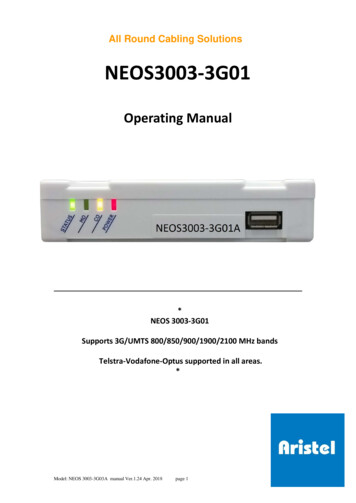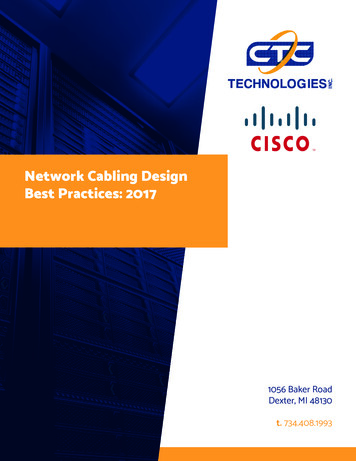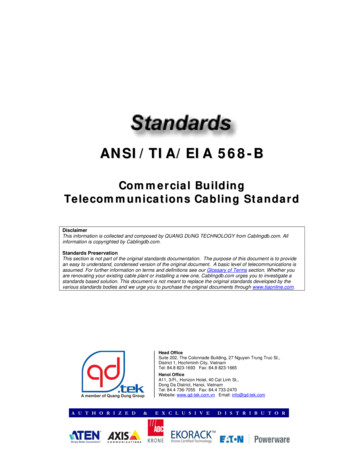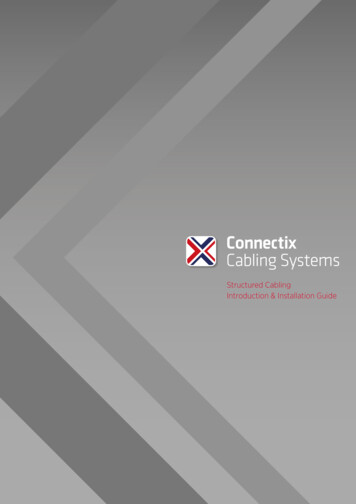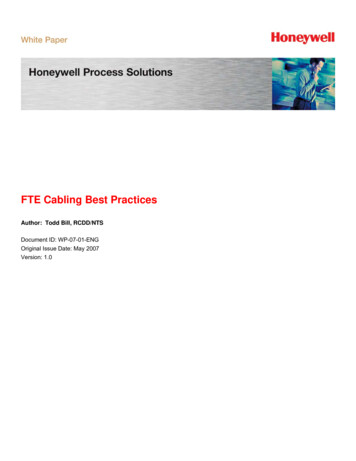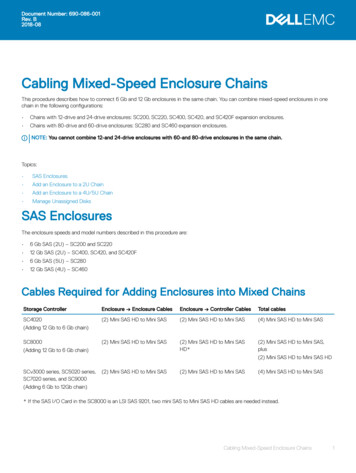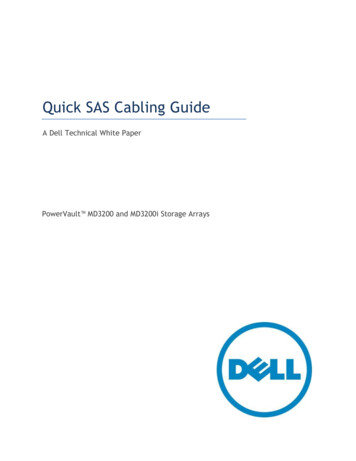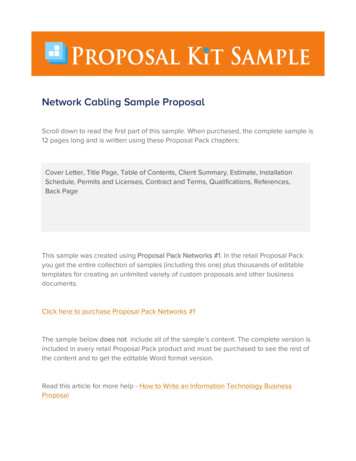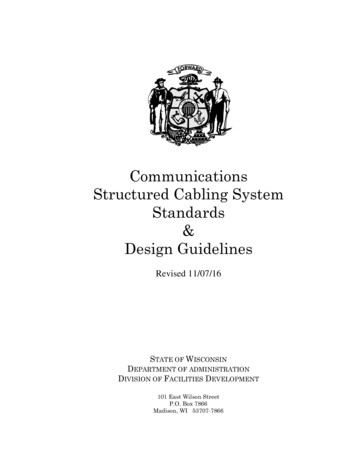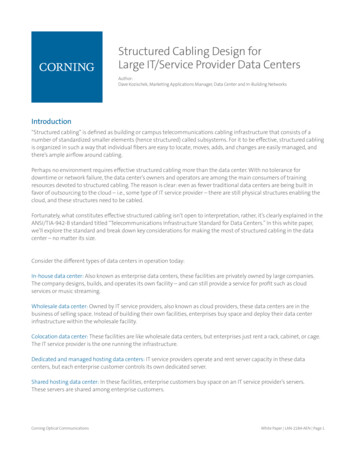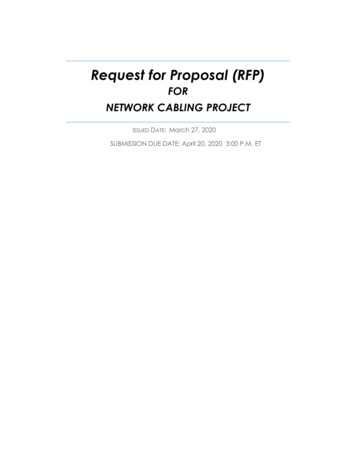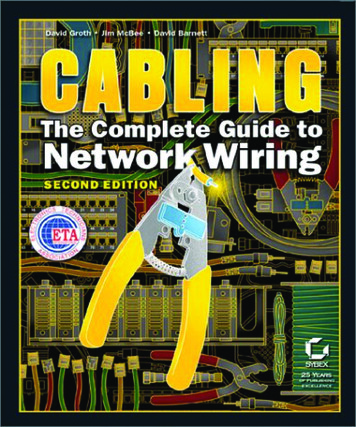
Transcription
Cabling: The CompleteGuide to Network WiringDavid GrothJim McBeeDavid BarnettSYBEX
Cabling: The Complete Guide to Network Wiring
This page intentionally left blank
Cabling: The Complete Guide to Network WiringDavid GrothJim McBeeDavid BarnettSan Francisco Paris Düsseldorf Soest London
Associate Publisher: Richard StaronAcquisitions & Developmental Editor: Maureen AdamsEditor: Joseph A. WebbProduction Editor: Liz BurkeTechnical Editor: Art BrievaBook Designer: Kris WarrenburgGraphic Illustrators: Eric Houts, Tony JonickElectronic Publishing Specialist: Franz BaumhacklProofreaders: Laurie O’Connell, Nancy Riddiough, Emily Hsuan,Yariv Rabinovitch, Suzanne SteinIndexer: Ted LauxCover Designer: Calyx DesignCover Illustrator: Richard Miller, Calyx DesignColor Insert: Owen Wolfson, Gareth Hopson PhotographyCopyright 2001 SYBEX Inc., 1151 Marina Village Parkway,Alameda, CA 94501. World rights reserved. No part of this publication may be stored in a retrieval system, transmitted, or reproduced in any way, including but not limited to photocopy,photograph, magnetic, or other record, without the prior agreement and written permission of the publisher.Library of Congress Card Number: 2001090464ISBN: 0-7821-2958-7SYBEX and the SYBEX logo are trademarks of SYBEX Inc. in theUSA and other countries.TRADEMARKS: SYBEX has attempted throughout this book todistinguish proprietary trademarks from descriptive terms by following the capitalization style used by the manufacturer.HALAR is a registered trademark of Ausimont USA, Inc.KYNAR is a registered trademark of Elf Atochem NorthAmerica, Inc.NeoFlon is a trademark of Daikin America, Inc.Crimplok is a trademark of 3M.The authors and publisher have made their best efforts to preparethis book, and the content is based upon final release softwarewhenever possible. Portions of the manuscript may be basedupon prerelease versions supplied by software manufacturer(s).The authors and the publisher make no representation or warranties of any kind with regard to the completeness or accuracy ofthe contents herein and accept no liability of any kind includingbut not limited to performance, merchantability, fitness for anyparticular purpose, or any losses or damages of any kind causedor alleged to be caused directly or indirectly from this book.Manufactured in the United States of America10 9 8 7 6 5 4 3 2 1
For my wife, my daughter, my family,and my friends.—D.G.This book is dedicated to my family(Mom, Dad, sisters, cousins, and aunts).Over a distance of thousands of miles and manyyears, you still influence my actions every day.We are all products of our environment;mine was great!—J.M.For Shan, Jordan, and Cameron.—D.B.
ACKNOWLEDGMENTSThis book has been a long time in the making. First and foremost, I would liketo acknowledge my coauthor, Jim McBee, for his excellent work on this project.He should be proud of his efforts, and it shows in the quality of this book. Also,we would like to acknowledge the other behind-the-scenes people that helped tomake this book, starting with Dan Whiting of Border States Electric Supply inFargo, ND, for all the reference material and pictures he and his company provided. His expertise was invaluable in the making of this book. Thanks, Dan! Wewould also like to thank photographer Steve Sillers for taking many of the pictures throughout this book.This book would not exist without Sybex Acquisitions and Developmental Editor Maureen Adams. Thanks for bringing Jim and me together and for managingthis project. Additionally, I would like to thank Editor Joe Webb for editing thisbook and Production Editor Liz Burke for managing its production. Also, I wouldlike to recognize the rest of the Sybex staff for all their hard work on this book,including (but not limited to) Eric Houts and Tony Jonick, the graphic illustrators;Owen Wolfson and Amy Changar, for their work on the color insert; all of theproofreaders (Laurie O’Connell, Nancy Riddiough, Suzanne Stein, Emily Hsuan,and Yariv Rabinovitch); the indexer Ted Laux; and electronic publishing specialistFranz Baumhackl, who spent time and effort making the book look good.Finally, I would like to recognize my wife, daughter, family, and friends, without whom I couldn’t do any of this and for whom I do this.—David GrothAt the Spring 1999 Networld InterOp, David Groth, Maureen Adams fromSybex, and I talked about the need for a book about network cabling that was targeted toward IT professionals and people just starting out with cabling. The firstedition was a resounding success, and now you hold a brand-new second editionin your hands!
Special thanks also goes to Janice Boothe, RCDD (and her awesome www.wiring.com Web site) and Mike Holt for their knowledge of codes. Paul Lucas, RCDD, ofPaul’s Cabling tolerated my nonstop questions and provided many great storiesand experiences. Kudos to Matt Bridges for his assistance with components. JeffDeckman gave his vital insight and input to the Request for Proposal (RFP) chapter; his cooperative approach to working with vendors will help many peoplesuccessfully deploy telecommunications infrastructures. Charles Perkins drewfrom his years of field experience to help with the case studies.Others who reviewed portions of the book and provided feedback includeMaureen McFerrin, Randy Williams, RD Clyde, John Poehler, and David Trachsel. Jeff Bloom and the folks at Computer Training Academy (where I teach Windows NT, TCP/IP, and Exchange courses) are always outstandingly patient whenI take on a project like this.Finally, the consummate professionals at Sybex always leave me in awe of theirskills, patience, and insight.—Jim McBeeI originally got involved with this book by assisting Jim McBee with the initialwriting of the first edition. Based on his recommendation, Sybex asked me torevise the book for the second edition. I’m grateful to Jim and everyone at Sybexfor entrusting me with the project. Thanks to all.Much of my cable knowledge was accumulated under the supervision of Dr.James S. Tyler, and I would be remiss if I didn’t acknowledge his significant contribution to my experience. Also, I would like to thank Jeanie Baer, RCDD, for herhelp and advice over the years and most recently for keeping me up-to-date onwhat’s happening in the TIA standards’ workgroups. Ron Hayes, practitioner ofthe black art of transmission engineering, deserves thanks and credit for sufferingme as his occasional sorcerer’s apprentice. I would like to thank Rob Jewson,RCDD, friend and business partner, for his advice and assistance.My wife, Shan, deserves special thanks for encouraging me to take on this project in addition to a “real” job plus a residential installation business, and thenputting up with the consequences. What were you thinking, dear?—David Barnett
CONTENTS AT A GLANCEIntroductionPart 1:Cabling Technology and ComponentsChapter 1: Introduction to Data CablingChapter 2: Cabling Specifications and StandardsPart 2:Part 3:xxix369Chapter 3: Choosing the Correct Cabling143Chapter 4: Cable System and Infrastructure Constraints189Chapter 5: Cabling System Components221Chapter 6: Tools of the Trade251Network Media and ConnectorsChapter 7: Copper Cable Media289Chapter 8: Wall Plates335Chapter 9: Connectors357Chapter 10: Fiber-Optic Media387Chapter 11: Unbounded (Wireless) Media421Cabling Design and InstallationChapter 12: Cabling-System Design and Installation449Chapter 13: Cable-Connector Installation489Chapter 14: Cable-System Testing and Troubleshooting527Chapter 15: Creating a Request for Proposal (RFP)569Chapter 16: Cabling @ Work: Experience from the Field601
ixAppendicesAppendix A: Dictionary of Cabling and TelecommunicationsTerms and Concepts623Appendix B: Cabling Resources711Appendix C: Registered Communications and DistributionDesigner (RCDD) Certification729Appendix D: Home Cabling: Wiring Your Home for Nowand the Future729Appendix E: Overview of IEEE 1394 and USB Networking739Appendix F: The Electronics Technicians Association,International (ETA) Data-Cabling InstallerCertification (DCIC) Program747Index753
This page intentionally left blank
CONTENTSIntroductionPART IxxixCabling Technology and Components1 Introduction to Data CablingThe Golden Rules of Data CablingThe Importance of Reliable CablingThe Cost of Poor CablingIs the Cabling to Blame?You’ve Come a Long Way, Baby: The Legacy of Proprietary CablingSystemsProprietary Cabling Is a Thing of the PastThe Need for a Comprehensive StandardCabling and the Need for SpeedTypes of Communications MediaTwisted-Pair CableOptical-Fiber CableCoaxial CableCable DesignPlenumRiserGeneral PurposeLimited UseCable JacketsCable MarkingsWire InsulationInsulation ColorsTwistsWire GaugeSolid Conductors versus Stranded ConductorsCable 1
xiiContentsData Communications 101Bandwidth, Frequency, and Data RateThe Secret Ingredient: Encoding and MultipairSimultaneous Send and ReceiveWhat a Difference a dB Makes!Digging a Little Deeper into DecibelsApplying Knowledge of DecibelsSpeed Bumps: What Slows Down Your DataHindrances to High-Speed Data TransferAttenuation (Loss of Signal)Noise (Signal Interference)Equal-Level Far-End Crosstalk (ELFEXT)Pair-to-Pair CrosstalkPower-Sum CrosstalkExternal InterferenceAttenuation-to-Crosstalk Ratio (ACR)Propagation DelayDelay SkewThe Future of Cabling Performance2 Cabling Specifications and StandardsStructured Cabling and StandardizationStandards and Specifying OrganizationsAmerican National Standards Institute (ANSI)Electronic Industries Alliance (EIA)Telecommunications Industry Association (TIA)Insulated Cable Engineers Association (ICEA)National Fire Protection Association (NFPA)National Electrical Manufacturers Association (NEMA)Federal Communications CommissionUnderwriters Laboratories (UL)International Organization for Standardizations (ISO)International Electrotechnical Commission (IEC)Institute of Electrical and Electronic Engineers (IEEE)National Institute of Standards and Technology (NIST)International Telecommunications Union (ITU)CSA International (CSA)ATM ForumEuropean Telecommunications Standards Institute 757577777878787879808080818282
ContentsBuilding Industry Consulting Services International (BICSI)Occupational Safety and Health Administration (OSHA)ANSI/TIA/EIA-568-A Cabling StandardANSI/TIA/EIA-568-A Purpose and ScopeSubsystems of a Structured Cabling SystemEntrance FacilityEquipment RoomBackbone CablingTelecommunications ClosetsHorizontal CablingWork AreaMedia and Connecting Hardware Performance100-Ohm Unshielded Twisted-Pair Cabling150-Ohm Shielded Twisted-Pair CablingOptical-Fiber CablingTelecommunications Systems nce FacilityMain-Terminal SpaceEquipment RoomTelecommunications ClosetsHorizontal PathwaysBackbone PathwaysWork AreasANSI/TIA/EIA-607ANSI/TIA/EIA-570-AOther TIA/EIA Standards and BulletinsISO/IEC 11801Classification of Applications and LinksAnixter Cable Performance Levels ProgramAnixter Levels: Looking ForwardWhat About Components?Other Cabling TechnologiesThe IBM Cabling SystemIBM Cable TypesIBM Data 34136137137138138140
xivContentsLucent SYSTIMAX SCS Cabling SystemDigital Equipment Corporation DECconnectNORDX/CDT Integrated Building Distribution System3 Choosing the Correct CablingTopologiesStar TopologyBus TopologyRing TopologyUTP, Optical Fiber, and Future-ProofingNetwork ArchitecturesEthernet10Mbps Ethernet Systems100Mbps Ethernet SystemsGigabit Ethernet (1000Mbps)Token RingToken Ring and Shielded Twisted Pair (STP)Token Ring and Unshielded Twisted Pair (UTP)Fiber Distributed Data Interface (FDDI)Cabling and FDDIAsynchronous Transfer Mode (ATM)Cabling and ATM100VG-AnyLANCable and 100VG-AnyLANCascadingNetwork-Connectivity DevicesRepeatersHubsBridgesSwitchesRouters4 Cable System and Infrastructure ConstraintsWhere Do Codes Come From?The United States Federal Communications CommissionThe National Fire Protection AssociationUnderwriters LaboratoriesCodes and the 90192194196
ContentsThe National Electrical CodeNEC Chapter 1 General RequirementsArticle 100—DefinitionsArticle 110-3 (b)—Installation and UseArticle 110-26—Spaces about Electrical EquipmentNEC Chapter 2 Wiring and ProtectionArticle 225-14 (d)—Conductors on PolesArticle 250—GroundingArticle 250-2 (c)—Bonding of Electrically ConductiveMaterials and Other EquipmentArticle 250-32—Two or More Buildings or StructuresSupplied from a Common ServiceArticle 250-50—Grounding-Electrode SystemArticle 250-52—Made and Other ElectrodesArticle 250-60—Use of Air TerminalsArticle 250-70—Methods of Grounding ConductorConnection to ElectrodesArticle 250-92 (b)—Bonding to Other ServicesArticle 250-104—Bonding of Piping Systems andExposed Structural SteelArticle 250-119—Identification of Equipment-GroundingConductorsNEC Chapter 3 Wiring Methods and MaterialsArticle 300-11—Securing and SupportingArticle 300-21—Spread of Fire or Products of CombustionArticle 300-22—Wiring in Ducts, Plenums, and OtherAir-Handling SpacesNEC Chapter 5 Special OccupancyArticles 500 through 504NEC Chapter 7 Special ConditionsArticle 725-1—ScopeArticle 760—Fire-Alarm SystemsArticle 770—Optical-Fiber Cables and RacewaysArticle 770-6—Raceways for Optical-Fiber CablesArticle 770-8—Mechanical Execution of WorkArticle 770-50—Listings, Marking, and Installationof Optical-Fiber CablesArticle 770-52—Optical-Fiber RacewaysArticle 770-53—Cable 09210211211
xviContentsNEC Chapter 8 Communications SystemsArticle 800-1—ScopeArticle 800-6—Mechanical Execution of WorkArticle 800-7—Hazardous LocationsArticle 800-10—Overhead Wires and CablesArticle 800-11—Underground Circuits Entering BuildingsArticle 800-30—Circuits Requiring Primary ProtectorsArticle 800-32—Secondary Protector RequirementsArticle 800-33—Cable GroundingArticle 800-40—Primary-Protector GroundingArticle 800-50—Listings, Markings, and Installation ofCommunications Wires and CablesArticle 800-50—Listing Requirements forCommunications Wires and Cables and CommunicationsRacewaysArticle 800-52—Installation of Communications Wires,Cables, and EquipmentKnowing and Following the Codes5 Cabling System ComponentsThe CableHorizontal and Backbone CablesHorizontal CablesBackbone CablesModular Patch CablesPick the Right Cable for the JobWall Plates and ConnectorsCabling PathwaysConduitCable TraysRacewaysFiber-Protection SystemsWiring ClosetsTIA/EIA Recommendations for Wiring ClosetsCabling Racks and EnclosuresWall-Mounted BracketsSkeletal Frames (19-Inch 38
ContentsFull Equipment CabinetsCable-Management AccessoriesElectrical GroundingCross-Connect DevicesThe 66 Punch-Down BlocksThe 110 and S-210 Punch-Down BlocksModular Patch PanelsConsolidation PointsFiber-Optic Connector PanelsAdministration Standards6 Tools of the TradeBuilding a Cabling Tool KitCommon Cabling ToolsWire StrippersCoaxial Wire StrippersFiber-Optic Cable StrippersWire CuttersCable CrimpersTwisted-Pair CrimpersCoaxial-Cable CrimpersPunch-Down ToolsFish TapesVoltage MeterCable TestingA Cable-Toning ToolTwisted-Pair Continuity TesterCoaxial TesterOptical-Fiber TestersCabling Supplies and ToolsCable-Pulling ToolsWire-Pulling LubricantCable-Marking SuppliesWall-Plate Marking SuppliesTools That a Smart Data-Cable Technician CarriesA Preassembled Kit Could Be 82283284285
xviiiContentsPART IINetwork Media and Connectors7 Copper Cable MediaTypes of Copper CablingMajor Cable Types Found TodayCategory 1 UTP CableCategory 2 UTP CableCategory 3 UTP CableCategory 4 UTP CableCategory 5/5e UTP CableCategory 6 UTP CableCategory 7 UTP CableShielded Twisted-Pair Cable (IBM Type 1A)Backbone UTP CableCoaxial CableHybrid or Composite CablePicking the Right Patch CablesWhy Pick Copper Cabling?Best Practices for Copper InstallationFollowing StandardsCable DistancesWiring PatternsPlanningCable ManagementInstalling Copper CablePulling CableSeparating Voice and Data Patch PanelsSheath SharingAvoiding Electromagnetic InterferenceCopper Cable for Data Applications110-BlocksSample Data InstallationsCopper Cable for Voice Applications66-Blocks25-Pair Wire AssignmentsSample Voice InstallationsTestingTone Generators and Amplifier 22325326330330
ContentsContinuity TestingWire-Map TestersCable CertificationCommon Problems with Copper CablingLength ProblemsWire-Map ProblemsNEXT and FEXT (Crosstalk) ProblemsAttenuation Problems8 Wall PlatesWall-Plate Design and Installation IssuesManufacturer SystemWall-Plate LocationVertical PositionHorizontal PositionWall-Plate Mounting SystemOutlet BoxesCut-In MountingSurface-Mount Outlet BoxesFixed-Design or Modular PlateFixed-Design Wall PlatesNumber of SocketsTypes of SocketsLabelingModular Wall PlatesNumber of SocketsWall-Plate Jack ConsiderationsWall-Plate System TypeCable ConnectionJack OrientationWiring PatternLabelingBiscuit JacksTypes of Biscuit JacksAdvantages of Biscuit JacksDisadvantages of Biscuit 4354355355356
xxContents9 ConnectorsTwisted-Pair Cable ConnectorsPatch-Panel TerminationsSolid- versus Stranded-Conductor CablesModular Jacks and PlugsWiring SchemesPins Used by Specific ApplicationsUsing a Single Horizontal Cable Run for Two10Base-T ConnectionsCrossover CablesShielded Twisted-Pair ConnectorsCoaxial Cable ConnectorsF-Series Coaxial ConnectorsN-Series Coaxial ConnectorsThe BNC ConnectorFiber-Optic Cable ConnectorsFiber-Optic Connector TypesThe SFF IssueInstalling Fiber-Optic Connectors10 Fiber-Optic MediaIntroduction to Fiber-Optic TransmissionAdvantages of Fiber-Optic CablingImmunity to Electromagnetic Interference (EMI)Higher Possible Data RatesLonger Maximum DistancesBetter SecurityDisadvantages of Fiber-Optic CablingHigher CostDifficult to InstallTypes of Fiber-Optic CablesComposition of a Fiber-Optic CableOptical FiberBufferStrength MembersShield MaterialsCable JacketAdditional Designations of Fiber-Optic CablesCore/Cladding 400401401401402
ContentsNumber of Optical FibersLAN/WAN ApplicationFiber Installation IssuesComponents of a Typical InstallationFiber-Optic EnclosuresFiber-Optic ConnectorsFiber-Optic Performance FactorsAttenuationAcceptance AngleNumerical Aperture (NA)Modal DispersionChromatic Dispersion11 Unbounded (Wireless) MediaInfrared TransmissionsHow Infrared Transmissions WorkPoint to PointBroadcastAdvantages of InfraredDisadvantages of InfraredExamples of Infrared TransmissionsIrDA PortsInfrared-Laser DevicesRadio-Frequency (RF) SystemsHow RF WorksLow Power, Single FrequencyHigh Power, Single FrequencySpread SpectrumAdvantages of RFDisadvantages of RFExamples of RFMicrowave CommunicationsHow Microwave Communication WorksTerrestrialSatelliteAdvantages of Microwave CommunicationsDisadvantages of Microwave CommunicationsExamples of Microwave 7437438440440441443444445446
xxiiContentsPART IIICabling Design and Installation12 Cabling-System Design and InstallationElements of a Successful Cabling InstallationProper DesignDesired Standards and Performance CharacteristicsFlexibilityLongevityEase of A
The Future of Cabling Performance 67 2 Cabling Specifications and Standards 69 Structured Cabling and Standardization 70 Standards and Specifying Organizations 73 American National Standards Institute (ANSI) 74 Electronic Industries Alliance (EIA) 75 Telecommunications Industry Association (TIA) 75 Insulated Cable Engineers Association (ICEA) 77File Size: 9MB

